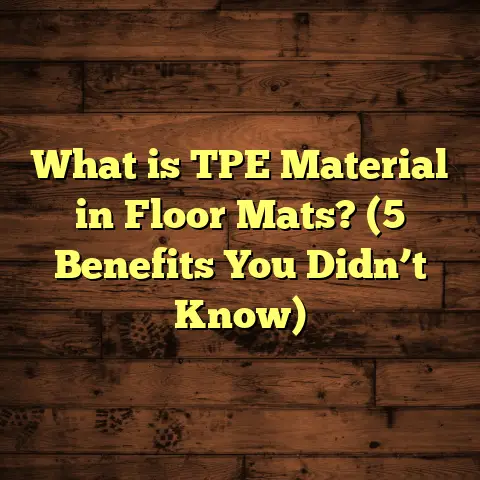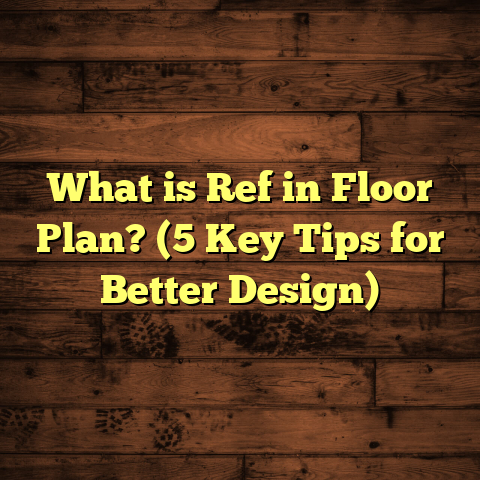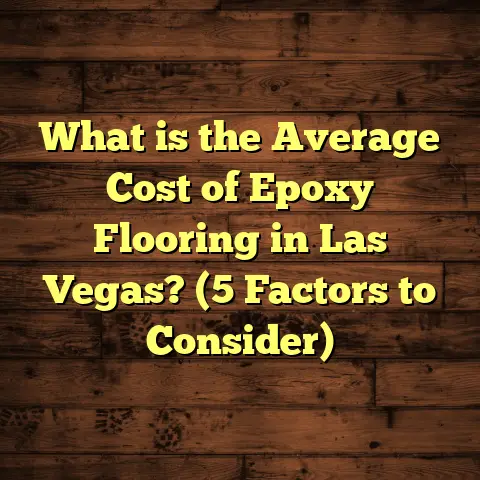What is Pre-Engineered Wood Flooring? (5 Key Benefits Explained)
You might think that wood flooring is all about solid hardwood planks, but what if I told you that some of the most durable and stylish wood floors come from a product that’s actually engineered? Sounds like a contradiction, right? How can something engineered be more natural or better than traditional wood? Well, that’s the paradox of pre-engineered wood flooring, and it’s something I’ve grown to appreciate deeply over years of working with various flooring materials.
What is Pre-Engineered Wood Flooring?
So, what exactly is pre-engineered wood flooring? Simply put, it’s a type of hardwood flooring made by layering real wood veneers over a core of plywood or high-density fiberboard (HDF). Unlike solid hardwood, which is one solid piece of timber, pre-engineered wood flooring combines multiple layers to create a more stable and versatile product.
The “pre-engineered” part means the flooring comes ready to install, with the layers already glued and pressed together during manufacturing. This construction method helps control how the wood reacts to changes in temperature and humidity, making it less prone to warping or shrinking compared to solid hardwood.
Let me break it down for you:
- Top Layer (Veneer): Thin slice of real hardwood (usually 2-6 mm thick)
- Core Layer: Multiple layers of plywood or HDF arranged in a cross-grain pattern
- Bottom Layer: Balancing layer to provide stability and support
This multi-layer setup gives the floor strength and flexibility while keeping the authentic wood appearance that everyone loves.
The Manufacturing Process: Why It Matters
Understanding how pre-engineered wood flooring is made helps explain why it performs so well. I’ve visited several manufacturing facilities over the years, and here’s what I learned about the process:
- Sourcing Raw Materials: Manufacturers select specific hardwood species for veneers—oak, maple, hickory, walnut are popular choices. The core layers often come from sustainably sourced plywood or recycled wood fibers.
- Layer Assembly: Layers are stacked crosswise—this means the grain of one layer runs perpendicular to the next. That structure counters the natural tendency of wood to expand or contract along its grain.
- Pressing and Gluing: The layers are glued under high pressure with adhesives designed to be moisture-resistant. This bonding ensures the planks act like one solid unit.
- Cutting and Finishing: After pressing, planks are cut to size and finished with protective coatings such as aluminum oxide or UV-cured polyurethane.
The precision in this process results in flooring that looks real but behaves better in challenging environments.
Why Choose Pre-Engineered Wood Flooring? Five Benefits I’ve Seen Make a Difference
When I first started installing floors, I was skeptical about anything that wasn’t solid hardwood. But after seeing how pre-engineered wood flooring performs over time, I became a big fan. Here are five key benefits that stand out from my experience:
1. Superior Dimensional Stability
If you’ve ever dealt with hardwood floors that cup, buckle, or gap after a change in seasons, you know how frustrating that can be. Pre-engineered wood flooring shines here because the layered construction resists movement caused by moisture and temperature swings.
In fact, studies show that engineered wood floors can reduce expansion and contraction by as much as 75% compared to solid hardwood. This means fewer repairs and a floor that stays looking great longer.
I remember a project in a coastal home where humidity was constantly changing. The pre-engineered floor stayed rock solid while neighboring solid wood floors showed visible gaps within months.
Why Stability Matters
Wood is hygroscopic—it absorbs and releases moisture from the air. When it does, it swells or shrinks depending on humidity levels. Solid hardwood floors are more vulnerable because they’re one continuous piece. Pre-engineered floors have layers going in different directions that counteract these movements.
From a technical standpoint:
- Solid hardwood can expand/contract roughly 1/4 inch per 10 feet.
- Engineered wood limits this movement to about 1/16 to 1/8 inch per 10 feet.
This difference is huge when you think about preventing floor damage or squeaky joints.
2. Easier Installation Options
One of the things I love about pre-engineered wood flooring is how flexible it is when it comes to installation. Because of its stability, it can be installed in places where solid hardwood often can’t—like basements or over radiant heating systems.
Plus, pre-engineered planks often come with click-lock systems or tongue-and-groove edges that make floating installations quick and clean. This saves time and labor costs, something every homeowner appreciates.
On a recent job, I installed engineered wood over an existing concrete slab without any issues—a task that would have been complicated with traditional hardwood.
Installation Methods Explained
There are three main ways to install pre-engineered wood flooring:
- Floating Floor: Planks snap together and “float” above the subfloor without being nailed or glued down. Great for DIYers due to speed and simplicity.
- Glue-Down: Adhesive is applied directly to the subfloor before laying planks. This provides a secure bond and reduces noise.
- Nail/Staple Down: Mostly used on wooden subfloors; nails or staples hold the planks in place for maximum stability.
Depending on your home’s subfloor type and conditions (like moisture level), you can choose the best method.
3. Cost-Effectiveness Without Sacrificing Appearance
You might expect pre-engineered wood floors to cost more because of the technology involved, but surprisingly, they often come at a lower price point than solid hardwood. The reason is that the top veneer uses less expensive slices of wood, and the core materials are more affordable than solid planks.
From my records, pre-engineered floors can be anywhere from 10% to 30% cheaper per square foot than their solid counterparts. Plus, because they’re easier to install, you save on labor too.
For homeowners on a budget who want the rich look of real wood, this balance is a big win.
Breaking Down Costs
Let’s talk numbers:
| Flooring Type | Average Cost per Sq Ft (Material + Installation) |
|---|---|
| Solid Hardwood | $8 – $15 |
| Pre-Engineered Wood | $6 – $11 |
| Laminate | $3 – $7 |
| Vinyl Plank | $2 – $6 |
These figures vary by region and quality but show how engineered wood sits comfortably in mid-range pricing.
4. Environmental Benefits: A Smarter Use of Wood
I’ve always cared about sustainability in flooring choices. Pre-engineered wood flooring makes better use of natural resources because only a thin layer of hardwood is used on top, while the core consists of faster-growing or recycled materials like plywood or HDF.
According to recent forestry data, using engineered wood can reduce the demand for old-growth timber by up to 50%, which helps conserve forests.
This eco-friendly aspect has convinced many clients who want beautiful floors without feeling guilty about their environmental impact.
Sustainable Sourcing Practices
More manufacturers now adopt certifications such as:
- FSC (Forest Stewardship Council): Guarantees wood comes from responsibly managed forests.
- PEFC (Programme for the Endorsement of Forest Certification): Similar certification promoting sustainable forestry.
When I recommend pre-engineered floors, I always encourage clients to look for these labels. The combination of reduced raw material usage and responsible sourcing makes a difference.
5. Long-Term Durability and Refinishing Potential
One concern I’ve heard from clients is whether engineered wood can be refinished like solid hardwood. The good news is yes—but with some limits.
Because the top veneer is thinner than solid wood planks, you generally get fewer sanding cycles—usually 2 to 3 refinishes compared to 5 or more for solid hardwood. Still, this is enough for most residential applications where floors last decades before needing major work.
In cases where thicker veneers (4-6 mm) are used, refinishing options improve even more. From my experience, these floors hold up beautifully under daily wear and tear and can be refreshed multiple times without compromising structure.
Real-Life Durability Stories
I once worked with a client who had a 5 mm thick veneer engineered floor installed in their living room. After ten years of heavy family use—kids running around, pets scratching—the floor still looked great after two refinishes.
That kind of performance shows this flooring isn’t just a budget alternative; it’s a lasting choice.
Deep Dive: Understanding Wood Species Used in Pre-Engineered Flooring
Choosing the right species for your floors affects not just looks but also durability and maintenance. Since pre-engineered floors use real wood veneers on top, all standard hardwood species are options here.
Popular Species I’ve Worked With
- Oak: The most common choice due to its hardness (Janka rating around 1290) and versatile grain pattern.
- Maple: Lighter color with smooth grain; slightly harder than oak.
- Hickory: Very hard (Janka rating ~1820), great for high traffic areas.
- Walnut: Darker tone with rich grain; softer than oak but elegant.
- Brazilian Cherry (Jatoba): Exotic and very hard (Janka ~2350), offers deep reddish hues.
What Species Means for Maintenance
Harder woods resist dents better but may show scratches more easily depending on grain structure.
For example:
- Oak hides scratches well due to its open grain.
- Maple’s smooth grain shows scratches more readily but is easier to clean.
When advising clients, I always consider lifestyle factors—kids? Pets? Heavy furniture? These guide species choice alongside aesthetic preferences.
Installation Insights: What I’ve Learned Over Hundreds of Jobs
Besides material choice, installation quality hugely impacts how well your floor performs long-term.
Acclimation Is Crucial
Wood wants to adapt to its surroundings before installation. From my experience:
- Acclimate planks indoors for at least 72 hours.
- Keep indoor humidity between 30-50%.
- Lay out bundles flat rather than standing on their sides.
Skipping acclimation risks gaps or buckling later on because the floor will try to adjust after installation when it’s harder to correct problems.
Subfloor Preparation
A clean, flat subfloor is essential:
- Concrete slabs need moisture barriers.
- Wooden subfloors should be checked for squeaks or rot.
- Leveling compounds can smooth out uneven areas under the floor.
I always spend extra time prepping because rushing this step leads to callbacks.
Cleaning and Maintenance Tips That Actually Work
Maintaining pre-engineered wood floors isn’t complicated but does require care:
- Sweep or vacuum regularly with a soft attachment.
- Avoid wet mopping; use a damp mop with manufacturer-approved cleaners.
- Use felt pads under furniture legs to prevent scratching.
- Keep pet nails trimmed.
- Control indoor humidity with humidifiers/dehumidifiers seasonally.
In my experience, clients who follow these tips keep their floors looking showroom fresh for years without refinishing sooner than needed.
Comparing Pre-Engineered Wood Flooring with Other Popular Choices
You may wonder how this flooring stacks up against alternatives like laminate or vinyl planks. Here’s what I’ve seen:
| Flooring Type | Durability | Installation Ease | Appearance | Cost Range ($/sq ft) | Moisture Resistance |
|---|---|---|---|---|---|
| Pre-Engineered Wood | High | Moderate | Real Wood Veneer | $4 – $10 | Moderate |
| Solid Hardwood | High | Difficult | Authentic Wood | $5 – $12 | Low |
| Laminate | Moderate | Easy | Imitation Wood | $1.50 – $5 | High |
| Luxury Vinyl Plank | High | Easy | Wide Variety | $2 – $7 | Very High |
Laminate and vinyl have advantages like moisture resistance and low cost but don’t offer real wood’s authentic feel or ability to refinish.
How Does Pre-Engineered Wood Flooring Perform Over Time?
Based on multiple projects spanning over 10 years:
- Floors maintain color well if UV-protective finishes are used.
- Minor scratches accumulate but are repairable with spot treatments or refinishing.
- Stability reduces warping issues common with solid hardwood.
- In high-moisture environments like kitchens or basements (if properly installed), these floors outperform solid hardwood significantly.
Exploring Design Trends Using Pre-Engineered Wood Flooring
The variety available today is amazing:
- Wide Plank Styles: Floors up to 7 inches wide create a modern yet warm look.
- Hand-Scraped Textures: Adds rustic character perfect for casual spaces.
- Matte Finishes: Popular for reducing glare and showcasing natural grain.
- Exotic Species: For those wanting unique colors beyond traditional oak or maple.
I enjoy helping clients choose combinations that fit their personalities while maximizing resale value.
Personal Anecdotes: Memorable Projects Involving Pre-Engineered Wood Floors
- Historic Home Renovation: The homeowner wanted original character but modern performance. We matched old-growth oak veneer planks over plywood cores allowing installation over radiant heat—a tricky requirement otherwise.
- Vacation Cabin: Extreme temperature swings demanded stable flooring. Engineered hickory proved perfect for durability and rustic charm.
- Urban Loft: The client wanted fast installation with minimal mess; floating pre-engineered maple floors delivered stylish results without long downtime.
Each project reaffirmed how versatile this flooring solution really is.
Frequently Asked Questions I Hear From Clients
Can pre-engineered wood flooring be installed over concrete?
Yes! It’s one of the biggest advantages over solid hardwood because engineered floors handle moisture better when paired with proper vapor barriers.
How thick should the veneer be for longevity?
Generally, veneers between 3 mm and 6 mm offer good durability and allow sanding/refinishing multiple times.
Will pets damage engineered wood?
Pets can scratch any wood surface; however, choosing harder species plus regular maintenance minimizes damage significantly.
Is pre-engineered flooring noisy?
Floating installations sometimes produce slight clicking sounds, but using quality underlayment reduces noise effectively.
Final Thoughts From My Experience
After years in the flooring business and countless installations under my belt, I’ve come to see pre-engineered wood flooring as one of the most practical choices out there for homeowners who want style and function combined.
It offers:
- Real wood aesthetics
- Greater dimensional stability
- Versatile installation methods
- Cost savings
- Environmental advantages
- Durable surface with refinishing potential
If you’re thinking about upgrading your floors but worry about moisture or budget constraints, this option deserves serious thought. From my perspective, it strikes a great balance that few other products manage so well over time.
Got questions? I’m here to help you figure out if pre-engineered wood might be right for your next project!





